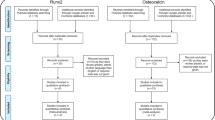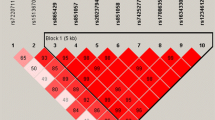Abstract
Introduction and hypothesis
Genetic studies of osteoporosis have focused on analysing single polymorphisms in individual genes – with inconclusive results. An alternative approach may involve haplotypes and gene-gene interactions. The aim of the study was to test the association between the COL1A1, ESR1, VDR and TGFB1 polymorphisms or haplotypes and bone mineral density (BMD) in Spanish postmenopausal women.
Methods
Sixteen polymorphisms were analysed in 719 postmenopausal women. ANOVA, ANCOVA and Xi2 tests were used to perform the statistical analysis.
Results
COL1A1 -1997G > T (p = 0.04) and TGFB1 Leu10Pro (p = 0.02) were found to be associated with adjusted lumbar spine (LS) BMD. Interactions were observed between: the COL1A1 -1997 G/T and Sp1 polymorphisms (p < 0.01 for LS BMD) and the COL1A1 -1663 indelT and VDR ApaI polymorphisms (p < 0.01 for femoral neck (FN) BMD). The COL1A1 GDs and ESR1 LPX haplotypes were associated with FN BMD (p = 0.03 and p = 0.03).
Conclusions
Polymorphisms at COL1A1 and TGFB1 and haplotypes at COL1A1 and ESR1 were found to be associated with BMD in a cohort of postmenopausal Spanish women. Moreover, COL1A1 polymorphisms showed significant interactions among them and with the VDR 3′ polymorphisms.

Similar content being viewed by others
References
Morrison NA, Qi JC, Tokita A et al (1994) Prediction of bone density from vitamin D receptor alleles. Nature 367:284–287. Erratum in: Nature (1997) 387:106
Recker RR, Deng HW (2002) Role of genetics in osteoporosis. Endocrine 17:55–66
Fang Y, van Meurs JB, d’Alesio A et al (2005) Promoter and 3′-untranslated-region haplotypes in the vitamin D receptor gene predispose to osteoporotic fracture: the Rotterdam study. Am J Hum Genet 77:807–823
Gennari L, Merlotti D, De Paola V et al (2005) Estrogen receptor gene polymorphisms and the genetics of osteoporosis: a HuGE review. Am J Epidemiol 161:307–320
Ioannidis JP, Ralston SH, Bennet ST et al (2004) Differential genetic effects of ESR1 gene polymorphisms on osteoporosis outcomes. Jama 292:2105–2114
Tzakas P, Wong BY, Logan AG et al (2005) Transforming growth factor beta-1 (TGFB1) and peak bone mass: Association between intragenic polymorphisms and quantitative ultrasound of the heel. BMC Musculoskelet Disord 6:29
Mann V, Ralston SH (2003) Meta-analysis of COL1A1 Sp1 polymorphism in relation to bone mineral density and osteoporotic fracture. Bone 32:711–717
Ralston SH, Uitterlinden AG, Brandi ML et al (2006) Large-scale evidence for the effect of the COLIA1 Sp1 polymorphism on osteoporosis outcomes: the GENOMOS study. PLoS Med 3:e90
Uitterlinden A, Ralston SH, Brandi ML et al (2006) The association between common vitamin D receptor gene variations and osteoporosis: a participant-level meta-analysis. Ann Int Med 145:255–264
Shen H, Liu Y, Liu P et al (2005) Nonreplication in genetic studies of complex diseases- lessons learned from studies of osteoporosis and tentative remedies. J Bone Miner Res 20:365–376
Huang QY, Recker RR, Deng HW (2003) Searching for osteoporosis genes in the post-genome era: progress and challenges. Osteoporos Int 14:701–715
Stumpf MP (2004) Haplotype diversity and SNP frequency dependence in the description of genetic variation. Eur J Hum Genet 12:469–477
Garcia-Giralt N, Nogues X, Enjuanes A et al (2002) Two new single-nucleotide polymorphisms in the COL1A1 upstream regulatory region and their relationship to bone mineral density. J Bone Miner Res 17:384–393
Garcia-Giralt N, Enjuanes A, Bustamante M et al (2005) In vitro functional assay of alleles and haplotypes of two COL1A1-promoter SNPs. Bone 36:902–908
Kobayashi S, Inoue S, Hosoi T et al (1996) Association of bone mineral density with polymorphism of the estrogen receptor gene. J Bone Miner Res 11:306–311
Arai H, Miyamoto KI, Yoshida M et al (2001) The polymorphism in the caudal- related homeodomain protein Cdx-2 binding element in the human vitamin D receptor gene. J Bone Miner Res 16:1256–1264
Langdahl BL, Gravholt CH, Brixen K et al (2000) Polymorphisms in the vitamin D receptor gene and bone mass, bone turnover and osteoporotic fractures. Eur J Clin Invest 30:608–617
Cambien F, Ricard S, Troesch A et al (1996) Polymorphisms of the transforming growth factor-beta 1 gene in relation to myocardial infarction and blood pressure. The Etude Cas-Temoin de l’Infarctus du Myocarde (ECTIM) Study. Hypertension 28:881–887
Sano M, Inoue S, Hosoi T et al (1995) Association of estrogen receptor dinucleotide repeat polymorphism with osteoporosis. Biochem Biophys Res Commun 217:378–383
Becherini L, Gennari L, Masi L et al (2000) Evidence of a linkage disequilibrium between polymorphisms in the human estrogen receptor alpha gene and their relationship to bone mass variation in postmenopausal Italian women. Hum Mol Genet 9:2043–2050
Barrett JC, Fry B, Maller J et al (2005) Haploview: analysis and visualization of LD and haplotype maps. Bioinformatics 21:263–265
Schaid DJ, Rowland CM, Tines DE et al (2002) Score tests for association between traits and haplotypes when linkage phase is ambiguous. Am J Hum Genet 70:425–434
Ioannidis JP, Stavrou I, Trikalinos TA et al (2002) Association of polymorphisms of the estrogen receptor alpha gene with bone mineral density and fracture risk in women: a meta-analysis. J Bone Miner Res 17:2048–2060
Langdahl BL, Carstens M, Stenkjaer L et al (2003) Polymorphisms in the transforming growth factor beta 1 gene and osteoporosis. Bone 32:297–310
Yamada Y (2001) Association of polymorphisms of the transforming growth factor- beta1 gene with genetic susceptibility to osteoporosis. Pharmacogenetics 11:765–771
Hinke V, Seck T, Clanget C et al (2001) Association of transforming growth factor- beta1 (TGFbeta1) T29->C gene polymorphism with bone mineral density (BMD), changes in BMD, and serum concentrations of TGF-beta1 in a population-based sample of postmenopausal German women. Calcif Tissue Int 69:315–320
Lau HH, Ho AY, Luk KD et al (2004) Transforming growth factor-beta1 gene polymorphisms and bone turnover, bone mineral density and fracture risk in southern Chinese women. Calcif Tissue Int 74:516–521
Dick IM, Devine A, Li S et al (2003) The T869C TGF beta polymorphism is associated with fracture, bone mineral density, and calcaneal quantitative ultrasound in elderly women. Bone 33:335–341
Ziv E, Kahn A, Cauley J et al (2003) No association between the TGF-beta 1 Leu10Pro polymorphism and osteoporosis among white women in the United States. Am J Med 114:227–231
Grant SF, Reid DM, Blake G et al (1996) Reduced bone density and osteoporosis associated with a polymorphic Sp1 binding site in the collagen type I alpha 1 gene. Nat Genet 14:203–205
Stewart TL, Jin H, McGuigan FE, Albagha OM et al (2006) Haplotypes defined by promoter and intron 1 polymorphisms of the COLIA1 gene regulate bone mineral density in women. J Clin Endocrinol Metab 91:3575–3583
Liu PY, Lu Y, Long JR et al (2004) Common variants at the PCOL2 and Sp1 binding sites of the COL1A1 gene and their interactive effect influence bone mineral density in Caucasians. J Med Genet 41:752–757
Zhang YY, Lei SF, Mo XY et al (2005) The -1997 G/T polymorphism in the COLIA1 upstream regulatory region is associated with hip bone mineral density (BMD) in Chinese nuclear families. Calcif Tissue Int 76:107–112
Yamada Y, Ando F, Niino N et al (2005) Association of a -1997G->T polymorphism of the collagen Ialpha1 gene with bone mineral density in postmenopausal Japanese women. Hum Biol 77:27–36
Uitterlinden AG, Weel AE, Burger H et al (2001) Interaction between the vitamin D receptor gene and collagen type I alpha1 gene in susceptibility for fracture. J Bone Miner Res 16:379–385
Patterson M, Cardon L (2005) Replication publication. PLoS Biol 3:e327
van Meurs JB, Schuit SC, Weel AE et al (2003) Association of 5′ estrogen receptor alpha gene polymorphisms with bone mineral density, vertebral bone area and fracture risk. Hum Mol Genet 12:1745–1754
Acknowledgements
Robin Rycroft provided editorial assistance. M.B. is the recipient of a fellowship from the Spanish Ministerio de Ciencia y Tecnología. This study was supported by grants from: the Spanish Ministerio de Ciencia y Tecnología (PM1999-0131-C02-01 y -02); the Spanish Ministerio de Educación y Ciencia (SAF2004-06085); the European Commission (GENOMOS Project; grant QLRT-2001-02629); the Spanish Ministerio de Sanidad (FIS 98/1952); and the Catalan Departament de Universitats, Recerca I Societat de la Informació (2005SGR 00762 and 2005SGR 00848).
Author information
Authors and Affiliations
Corresponding author
Rights and permissions
About this article
Cite this article
Bustamante, M., Nogués, X., Enjuanes, A. et al. COL1A1, ESR1, VDR and TGFB1 polymorphisms and haplotypes in relation to BMD in Spanish postmenopausal women. Osteoporos Int 18, 235–243 (2007). https://doi.org/10.1007/s00198-006-0225-8
Received:
Accepted:
Published:
Issue Date:
DOI: https://doi.org/10.1007/s00198-006-0225-8




